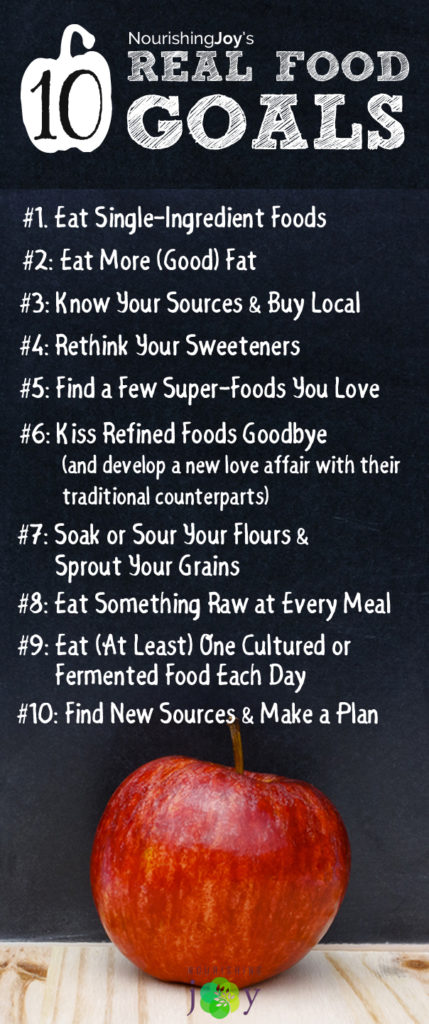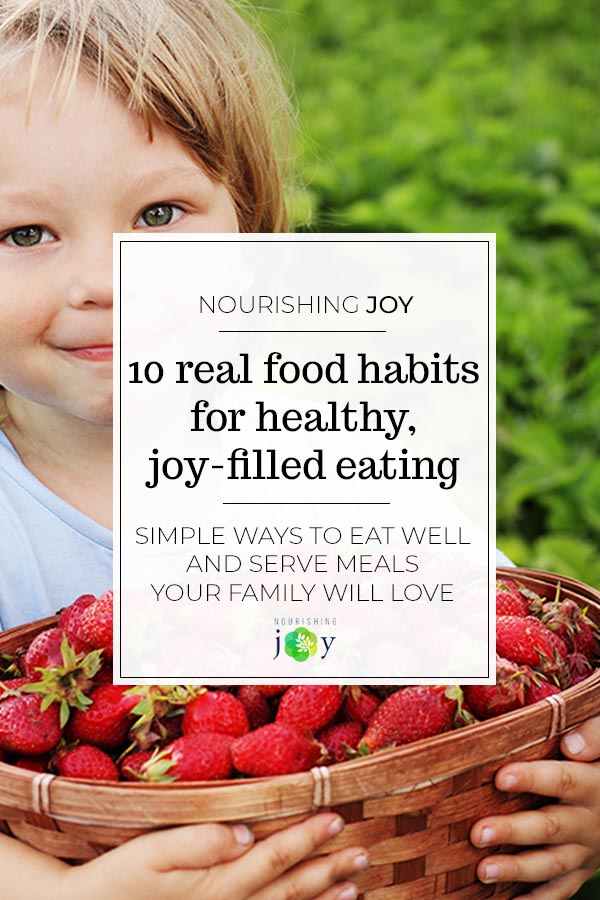10 Real Food Goals for Healthy, Joy-Filled Eating
This post may contain affiliate links, including those from Amazon.com, which means we earn a small commission off your purchases. And here's the thing: We only mention services and products that we think are truly worth your attention, whether they're free, paid, or otherwise. This site relies on YOUR trust, so if we don't stand behind a product 110%, it's not mentioned. Period.



When you want to eat more healthily, it can sometimes be difficult to know where to start.
Do you start with a crash diet? Do you swear off one certain food group (grains, dairy, meat, etc)? Do start drinking smoothies or juicing every day?
New lifestyles and new habits can be confusing and overwhelming!
However, it can be easier than you think! Back in 2011, I categorized ten things you can do to eat real food and now, in 2021, I've updated the list to help made it SIMPLE to choose even just one to add to your habits this year, or use all ten as a framework for a new way of eating. As usual, we want to minimize stress, not add to your overwhelm!
Thus, in our pursuit of nourishing ourselves and our families, I offer these ten eleven goals to guide our thinking and purchasing.
Want to hear about my story and why I chose these ten? Read What is Real Food? What is Sustainable Living?
10 Simple Ways to Eat Healthy (or at least, eat healthier 😊)
Real Food Goal #1: Eat Single-Ingredient Foods
Single-ingredient foods are just that – foods that are simply themselves. For example, “cream of mushroom soup” might be listed as an “ingredient” on some casserole recipes, but it itself is a collection of ingredients. Single ingredients are things like “mushrooms,” “cream,” and “onions.”
Things like bread might seem more confusing, but they're not. Are the ingredients listed single ingredients? Bread doesn't need much more than flour, water, yeast, and salt, with perhaps the exception of eggs, butter, and fruits or vegetables (in quick and sweet breads). Dough conditioners and preservatives are out.
Thus, in your cooking, only use single ingredients. Healthy and wholesome is as simple as that.
Real Food Goal #2: Eat More (Good) Fat
Fats that are naturally occurring, such as avocados, coconut oil, olive oil, butter, and foods rich in omega-3 fatty acids are not only healthy for you, but essential. These keep sugar cravings at bay, assist in cellular communication, and help your brain function optimally. Eating plenty of healthy fats has also been shown to be a crucial building block for living a longer and healthier life.
Real Food Goal #3: Know Your Sources and Buy Local
For me, eating real food isn't just because it's healthier for my family, but because it also helps the health of my local community.
By sourcing foods that are grown locally, not only am I keeping my grocery dollars from being spent for lettuce and peppers that were grown thousands of miles from where I live and brought on a truck cross-country, but I also know that the money I spend supports a family right here in my community. To me, supporting these sustainable systems is just as important as knowing the nutrients in my food.
And for the foods that DON'T grow near me, I'm okay with having the food trucked long-distance because it's for a short-time and truly isn't available locally.
And even in that case, do your research and buy farm-direct when possible – it's the beauty of “global made local.” In my case, I love to buy maple syrup from The Polk Around Farm, oranges and olive oil from Chaffin Orchards, and cranberries from Cape Cod Select (since I no longer live in the Pacific Northwest, surrounded by cranberry bogs… ::sniff, sniff:: )
Real Food Goal #4: Rethink Your Sweeteners
Sugar is delicious, but it can cause actual physical damage to our bodies, causing impaired cognitive function, compromised absorption of needed vitamins and minerals, and has even been shown to reduce immunity for up to six hours immediately following consumption.
However, I don't necessarily advocate ditching sweeteners altogether (although there is a time to do so). Instead, simply minimize your consumption and know what what benefits your sweeteners provide.
For example, raw honey contains vitamins, minerals, and enzymes that help break down other carbohydrates, as well as strong anti-viral, anti-bacterial, and anti-fungal properties due to the presence of propolis and bee pollen remaining in the honey.
Also, remember that a sweetener doesn’t have to be sugar to be sweet. Using spices such as cinnamon, nutmeg, cloves, and ginger or plant extracts such as stevia, mint, and lavender can give the sensation of a sweet treat without the overload of sugar.
So, my recommendation: Avoid white refined sugar at all cost. Use minimally refined sugars when needed and use sweet and warming herbs and spices liberally.
Related Articles:
Real Food Goal #5: Find a Few Super-Foods You Love
There are such things as super-foods: foods that pack a nutritional punch for the amount that you eat.
Some popular favorites: dark leafy greens (like kale), dark berries (like blueberries and cranberries), eggs, salmon, cooked tomatoes, beets, and nuts.
See – there's bound to be a few super-foods you love! Stock up on them and eat them frequently.
Real Food Goal #6: Kiss Refined Foods Goodbye (and develop a new love affair with their traditional counterparts)
Conventional foods and many pre-made convenience foods are absolutely loaded with ingredients that either aren't food or are so processed that they include preservatives, fillers, flavor enhancers, artificial dyes, and absolutely way too much refined sugar.
A couple of years ago I wrote a LOOOOONG article looking at ingredients you want to avoid, but to keep it simple, just ditch the refined foods altogether and cook from single ingredients.
That said, you can amp up the nutritional bang-for-your-buck by not only avoiding the processed store-bought version, but by embracing the traditional food that the store-bought one was emulating.
For example, if you regularly have purchased sandwich bread but recently discovered it lists high fructose corn syrup on the label, then find a brand that avoids the additives (or even better, also sprouts their grains) or learn how to make gorgeous sandwich bread from a sourdough starter. Once you've done it a couple of times, it's second nature. (See The Clever Carrot's simple, simple recipe here.)
Related Resources:
- 7 Foods to Avoid
- The Fake Food You Don't Know You're Eating
- I've also written two books about homemade pantry staples in a passionate effort to make it easy to switch away from the store-bought, processed varieties of condiments and convenience foods: Restocking the Pantry (an instant download) and The DIY Pantry (paperback).
Real Food Goal #7: Soak or Sour Your Flours and Sprout Your Grains
Think of it this way: grains are seeds. Therefore, they act like seeds. Seeds only germinate and grow once they’re in the right conditions, such as those as we move from winter into spring: basically warm and wet.
And once they germinate, they grow great gonzos, which is due to the fact that everything they need to nourish themselves for those first few days of growth is in the seed itself. Those nutrients and enzymes are stored up and saved until they’re “unlocked” by the warm, wet conditions, then they feed the newly sprouted plant and nourish it until the plant has rooted and can absorb nutrients from the soil and the sun.
But what keeps those seeds from sprouting early are anti-nutrients – these are binding agents that “lock up” and preserve the nutrients until they’re needed.
So, all this is still true when we eat those seeds, including grains.
If we eat grains without “unlocking” those enzymes and nutrients, our bodies can only minimally digest or absorb the nutrients. Much of the goodness of whole grain falls short.
Thus soaking, sprouting, and souring the grains are three ways to break down the anti-nutrients (such as phytic acid), make the nutrients more bio-available, and soften the gluten for easier digestibility.
Related Articles:
Real Food Goal #8: Eat Something Raw at Every Meal
Cooked foods are lovely. Cooking foods creates lovely textures, alluring flavors, and easy-to-digest foods that are good for our gut.
But raw foods are necessary too. Vitamins and enzymes that are essential for our bodies are denatured by heating them. They also provide important roughage that is important for colonic health. Raw foods are often very hydrating as well – think of crunching into cucumbers, celery, and Romaine that refresh deeply.
Related Articles:
Real Food Goal #9: Eat (At Least) One Cultured or Fermented Food Each Day
Cultured and fermented foods provide probiotics to our guts and entire digestive system in far more important ways than we even know. The billions upon billions of micro-organisms that proliferate in properly fermented foods keep us healthy, boost our immune systems, make it possible to actually USE the nutrients in the food we eat, and so much more.
Considering that the gut is where more than 95% of our digestion and absorption of nutrients take place, this is vastly important!
And interestingly enough, fermenting vegetables can actually INCREASE their nutritional value (which is a wonderfully welcome thing when fresh cabbage that was picked in autumn is no longer available, but the sauerkraut made from it is still refreshingly good in the late winter months of January and February).
Best of all, sauerkraut and yogurt may be the poster childs for fermented and cultured foods, but they are far from the only ways to eat them! Fermented foods include salami, sour cream, lox, sourdough bread, pickles, kombucha, and many many more!
Related Articles:
- How to Make Perfect Homemade Sauerkraut
- 10 Surprising Reasons to Eat More Cultured & Fermented Foods
- Easy Ways to Eat More Cultured & Fermented Foods
- 101 Fabulous Fermented Foods
- Traditional Cooking School – this online cooking school excels at teaching everything from how to ferment and culture food to how to deal with grains and making your real food life easier with the Instant Pot (yes, there's an entire course dedicated to exactly that!). Whether it's confidence or skill that you need, TCS is your best learning tool.
Real Food Goal #10: Develop New Rhythms, Find New Sources, and Make a Plan (or What to Do When Good Intentions Go Awry)
And the most important goal of all: be patient with yourself! It is rather inevitable that everything will be going well for weeks on end and then suddenly you'll get busy – and you'll either slip back into old habits or just start taking shortcuts you don't really want to make.
So, make a list of foods and dishes your family loves and on the days when you find yourself short on ideas for dinner, consult the list so you don't end up ordering out or making a box of packaged something. Preferably, these are meals that are quick and simple so that you actually make them in a pinch.
Or use a meal planning service so that you can get into a new habit while someone else has already done the planning for you. There are TONS of good real food meal planning services, so just look around for one you like.
You might also want to try something completely new! Drinking a smoothie every day is a great way to get greens and vegetables in your diet, for example, so just adding that one new habit might be just what you need, rather than adding the stress of making lots of changes.
And if making everything at home is overwhelming (which it often is for the first few weeks/months/years), find sources to purchase good quality equivalents. Your local farmer's market can be an excellent source, as can a local health food store and the recommendations of friends. Sourdough and sprouted bread, traditional sauerkraut, condiments, and other kitchen staples can often be found fairly easily.
Related Articles & Resources:
- 31 Cheap, Last Minute Real Food Dinner Ideas
- New Year, New You Detox Smoothie
- Orange Tropical Turmeric Smoothie
Recommended Meal Planning Services:
- 12 Months of Real Food Meal Plans for Busy Families (We wrote these to provide busy families a simple, ready-made solution to cook healthy food for an entire year! You'll receive the entire year of meal plans instantly. AND if you click through to purchase the meal plans using the link here, you'll get nearly a 50% discount! You won't see it until checkout though – just be forewarned. 😊)
- Real Plans – rave reviews from traditional and real food enthusiasts across the board
- Once a Month Meals – freezer cooking at its best!
Real Food Goal #11 (Bonus!): Eat More Vegetables
I originally published this article with just ten real food goals, but I wanted to add this eleventh one simply because eating more vegetables is an easy easy way to eat more healthily, even though it isn't always easy to remember. (It's the goal *I'm* working on this year….)
This really ties in with both Goal #8 and Goal #9, but since there are so many ways to enjoy vegetables: raw, fermented, cooked, juiced, stewed – I wanted to add it as its own real food goal.
Want a bit of inspiration or help to know how to creatively add more vegetables into your meals? The book Vibrant Food is truly a celebration of seasonal eating and just makes you want to eat every. single. vegetable. RIGHT NOW!
Happy eating, everyone!






I changed my diet radically just after COVID started and am dairy, grain and sugar free to keep my sugars under control so I don’t get diabetes, I am pre-diabetic. So those drastice measures were hard, but I did it with my sister. We support each other and send recipes back and forth to stay on track. We are willing to make the big changes because of long term goals which are staying healthy so I can be around and healthy for my 9 grandchildren. I am feeling better and am at a healthy weight with exercise regularly. I think what helped me make the changes I needed to make was thinking of how my dad’s (who had diabetes) health went drastically downhill the last few years. I don’t want that to happen to me.
Wow! That’s really inspiring, Carol. Thank you for sharing your story. <3
I’m going to try to eat a fermented or cultured food daily. I can do this by making sure I have yogurt and sauerkraut as standard staples in our household.
Love it, Nichol!
Thank you for this post, Kresha, and the “challenges” in it. I have gotten DH on board with our homemade yogurt. Next up, for us KOMBUCHA! But for me, I shall try to eat a fermented/cultured food every day and include more vegetables–I am hoping for some HOMEGROWN!–in my family’s meals. God bless!
Ooo! Cool! I hope your garden crops turn out fabulously. 🙂
A recent challenge I saw on The Consistency Project is the 800 gram challenge — try to eat 800 grams of fruits and vegetables every day. It is surprising how full you feel and you don’t really want so many of those processed things!
Oh, interesting! I hadn’t thought of approaching it that way before. Very intriguing. 🙂 Thank you for sharing!